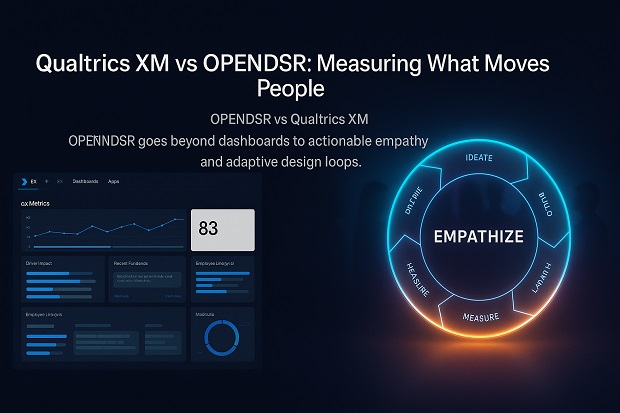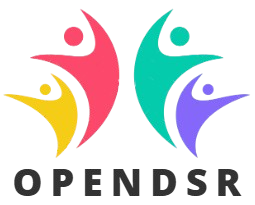
Qualtrics XM vs OPENDSR: Measuring What Moves People
Qualtrics XM vs OPENDSR: Measuring What Moves People
Introduction: From Measuring Experiences to Moving People
The world of Employee Experience (EX) has never been more data-rich—or more emotionally complex.
Surveys, dashboards, and analytics platforms promise to capture every pulse, every sentiment, every interaction. Yet despite oceans of experience data, many organizations still struggle to create genuine connection and behavioral change.
That’s because data alone doesn’t move people. Empathy does.
Two frameworks represent these contrasting paradigms:
-
Qualtrics XM (Experience Management Platform) — a pioneer in capturing and analyzing experience data (X-data) and operational data (O-data).
-
OPENDSR (Observe, Prioritize, Envision, Navigate, Design, Systematize, Refine) — a human-centered experience operating framework that transforms those insights into adaptive, empathetic action.
This article explores Qualtrics XM vs OPENDSR — not as competitors, but as complementary systems that together can evolve the future of employee experience: one that measures what matters and moves what matters.
1. Foundations of Each Framework Aspect Qualtrics XM OPENDSR Type Platform (Experience Management System) Framework (Human-Centered Operating System) Core Function Capture and analyze experience data (X-data) Translate human experiences into adaptive design loops Approach Quantitative, survey-driven, analytics-led Empathy-led, behaviorally informed, iterative Primary Output Dashboards, reports, predictive insights Prototypes, experience interventions, governance models Strength Scalable measurement Adaptive design and emotional depth Origin Qualtrics (acquired by SAP; global leader in XM) HCX (Human-Centered Experience) framework under OPENDSR movementQualtrics XM excels at systematically capturing feedback, identifying patterns, and generating insight dashboards. It has become the backbone of EX analytics for many global organizations.
OPENDSR, however, begins where dashboards end. It brings human psychology, empathy, and iterative design thinking into the system—ensuring insights lead to emotional resonance and real behavioral change.
2. The Promise of Qualtrics XM: Listening at ScaleQualtrics XM (Experience Management) revolutionized the feedback economy. Its vision: measure every experience, across every stakeholder, in real time.
Key Capabilities-
X + O Data Integration – Combines experience data (employee feedback, sentiment) with operational data (HRIS metrics, turnover, performance).
-
Journey Analytics – Maps and measures critical touchpoints across the employee lifecycle—from onboarding to exit.
-
Predictive Intelligence – Uses AI to forecast attrition, engagement shifts, or customer satisfaction drops.
-
Action Planning – Provides data-backed recommendations and accountability dashboards for HR and leadership.
-
Quarterly pulse surveys across 60,000 employees.
-
AI-driven insights flag early burnout risks.
-
Leadership dashboards visualize engagement trends per business unit.
Qualtrics gives organizations clarity through numbers. It tells you what’s happening, when, and sometimes why.
Yet, there’s an enduring question:
“After we measure everything… what actually changes?”
3. The OPENDSR Difference: Designing What MovesOPENDSR answers that question by operationalizing empathy.
It transforms “data points” into “design moments” through a seven-step adaptive loop:
Step Purpose 1. Observe Capture signals — quantitative and emotional — from real work environments 2. Prioritize Identify patterns and moments that truly matter to humans 3. Envision Co-create what the improved experience should feel like 4. Navigate Map the journeys and obstacles employees face 5. Design Prototype small interventions that influence trust, flow, and clarity 6. Systematize Embed effective practices into governance and culture 7. Refine Create real-time feedback loops for continuous improvementOPENDSR doesn’t stop at insight. It moves into meaning, design, and system change.
It brings empathy, reflection, and iterative design into the same operational rhythm that analytics platforms like Qualtrics enable.
In short:
-
Qualtrics measures sentiment.
-
OPENDSR moves sentiment.
Qualtrics handles millions of survey responses, instantly generating heatmaps, correlation scores, and insights.
For global enterprises, this scalability is unmatched.
With AI and ML capabilities, it forecasts outcomes like turnover, engagement, or satisfaction trends—crucial for proactive HR strategy.
3. Integration EcosystemConnects easily with HR systems like SAP SuccessFactors, Workday, ServiceNow, and Microsoft Viva.
4. Benchmarking and StandardizationIt provides global benchmarks, allowing organizations to compare EX performance against peers in their industry.
In short, Qualtrics is the analyst’s dream—a data powerhouse that reveals trends faster than traditional surveys ever could.
6. Where OPENDSR Transforms 1. Empathy-First DesignRather than surveying people, OPENDSR observes them in motion—capturing the stories behind the scores.
It reframes data into dialogue.
Each insight leads to design action. If Qualtrics highlights a drop in “sense of belonging,” OPENDSR co-designs rituals, communication touchpoints, or leadership micro-behaviors to rebuild it.
3. Continuous AdaptationReal-time feedback ensures experiences evolve dynamically, not annually.
4. Human-Centered GovernanceOPENDSR introduces roles like:
-
EX Owner – who designs experiences, not policies
-
Moment Designer – who curates critical experiences
-
HCX Data Steward – who bridges data with empathy
Together, these roles turn static dashboards into living ecosystems.
7. A Practical Example: Bridging XM and Human DesignScenario: A tech company observes declining engagement in hybrid teams.
Stage Qualtrics XM Action OPENDSR Activation Observation Survey reveals 40% feel disconnected post-COVID Conduct “Observe” sessions through digital diaries and listening circles Insight Data shows drop in collaboration scores Emotional mapping identifies fatigue and lack of recognition Design HR issues engagement toolkit Co-create “Moments of Appreciation” micro-practices at team level Follow-up Quarterly re-survey Real-time refinement through peer-led reflection loopsThe difference?
Qualtrics delivers awareness; OPENDSR delivers alignment.
One sees; the other senses.
Together, they complete the feedback-to-action loop.
Most EX systems today operate as feedback collectors. They tell organizations what employees feel but not how to respond meaningfully.
OPENDSR adds a design layer over measurement systems like Qualtrics:
-
Translates data into design
-
Turns insight into behavior
-
Builds adaptive feedback loops
In essence, OPENDSR transforms the EX process from a reactive survey cycle to a living experience rhythm.
10. Visual Concept: From Dashboard to Empathy WheelImagine the typical EX dashboard—graphs, scores, sentiment heatmaps.
Now imagine that dashboard morphing into a glowing empathy wheel, where every data point pulses with human stories, emotions, and adaptive feedback loops.
That’s OPENDSR in motion—where measurement meets meaning.
11. Synergy Model: XM + OPENDSR XM Function OPENDSR Layer Combined Outcome Employee Pulse Survey Observe + Prioritize Emotionally validated signals Sentiment Analysis Envision Translate analytics into empathy insights Journey Mapping Navigate Co-design real journeys that remove friction Action Planning Design Prototype, test, and embed adaptive experiences Follow-up Surveys Refine Real-time improvement and loop closureTogether, Qualtrics XM provides the data, while OPENDSR ensures it leads to design, dialogue, and development.
12. Leadership ImplicationsExecutives today must move from being data consumers to experience designers.
-
Qualtrics equips them to see patterns.
-
OPENDSR equips them to feel patterns.
With OPENDSR embedded, leaders don’t just monitor dashboards—they host dialogues, redesign rituals, and reinforce human connection.
“Data may tell you what people say. OPENDSR helps you hear what they mean.”
13. The Future of Experience: Adaptive Empathy SystemsIn the coming decade, EX platforms will evolve beyond survey tools into adaptive empathy systems—platforms that sense, learn, and respond dynamically.
This future looks like:
-
AI + Human Insight Co-design: Predictive analytics validated through empathy loops
-
Moment-Based Feedback: Continuous emotional sensing during key work experiences
-
HCX Governance: Experience stewards and data translators embedded in business units
Qualtrics provides the intelligence.
OPENDSR provides the conscience.
Qualtrics XM changed how we measure experience.
OPENDSR changes how we live it.
While Qualtrics helps organizations hear the voice of the employee, OPENDSR helps them sense the heart of the employee.
When combined, they form a powerful continuum:
Qualtrics measures what matters. OPENDSR moves what matters.
Together, they create the next frontier in EX—from dashboards to empathy wheels, from data to design, and from measurement to movement.








